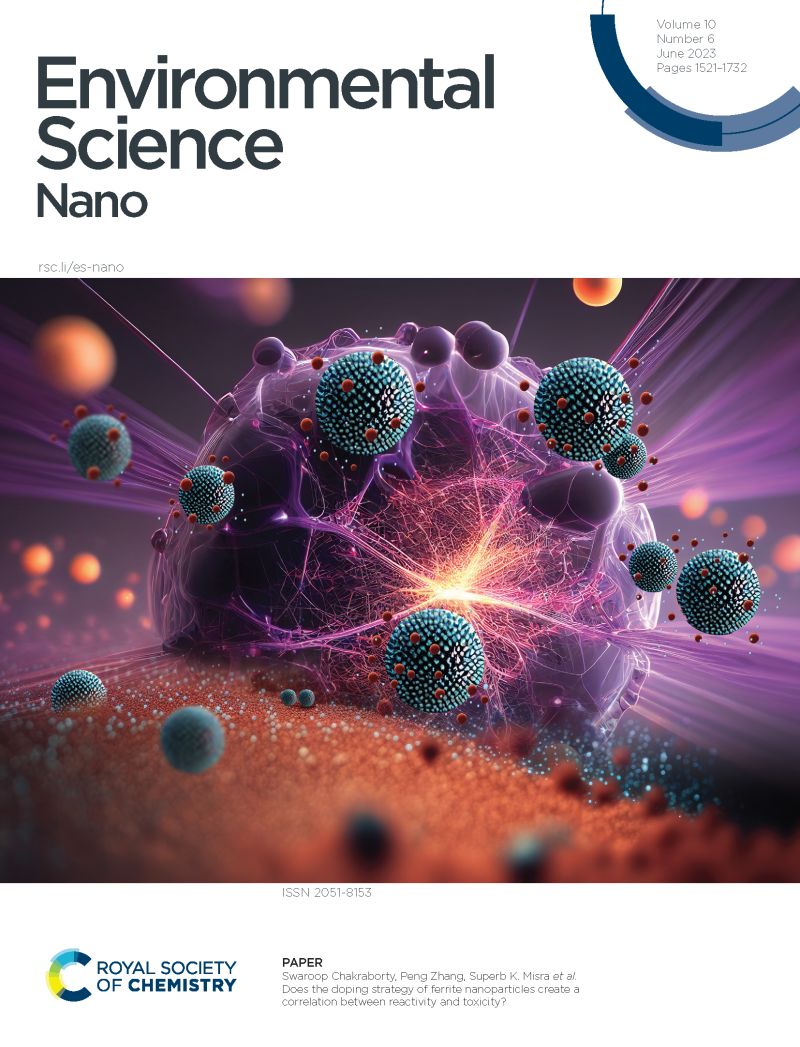整合转录组学和蛋白质组学数据,了解碳基纳米材料对植物耐盐胁迫的积极作用机制
IF 5.8
2区 环境科学与生态学
Q1 CHEMISTRY, MULTIDISCIPLINARY
引用次数: 0
摘要
碳基纳米材料可以调节种子萌发、植物生长和对环境胁迫的响应。对这些积极作用背后的生物学机制的理解是有限的。整合转录组学、蛋白质组学和代谢组学数据,即多组学数据整合,是揭示CBNs在植物分子水平上影响的分子机制的有力策略,为其生物学影响提供了详细的见解。在这里,我们结合转录组学(RNA-Seq)和蛋白质组学(串联质谱)数据来了解暴露于CBNs(碳纳米管(CNTs)和石墨烯)的番茄植株对盐胁迫耐受性提高的机制。在蛋白质组水平上,暴露于CNTs导致盐胁迫下番茄幼苗中358个蛋白的表达完全恢复,697个蛋白的表达部分恢复。同样,暴露于石墨烯导致受盐胁迫影响的587种蛋白质完全恢复,644种蛋白质部分恢复。在转录组学和蛋白质组学数据的综合分析中,86个上调和58个下调的特征在暴露于CBNs的nacl胁迫幼苗的两个组学水平上显示出相同的表达趋势(向正常水平恢复表达)。我们的数据表明,cdn处理后番茄耐盐性的提高可能与活化MAPK和肌醇信号通路、增强ROS清除、刺激激素和糖代谢、通过水通道蛋白的工作调节水分吸收、调节热休克蛋白的产生以及促进具有防御功能的次级代谢物的产生有关。本文章由计算机程序翻译,如有差异,请以英文原文为准。
Integration of Transcriptomics and Proteomics Data for Understanding the Mechanisms of Positive Effects of Carbon-Based Nanomaterials on Plant Tolerance to Salt Stress
Carbon-based nanomaterials (CBNs) can regulate seed germination, plant growth, and response to environmental stresses. Understanding of the biological mechanisms underlying these positive effects is limited. Integrating transcriptomics, proteomics, and metabolomics data—known as multi-omics data integration—is a powerful strategy for uncovering the molecular mechanisms underlying the effects of CBNs on a plant's molecular level, providing detailed insights into their biological impacts. Here, we combined transcriptomic (RNA-Seq) and proteomics (Tandem MS) data to understand mechanisms of improvement of tolerance to salt stress in tomato plants exposed to CBNs (carbon nanotubes (CNTs) and graphene). At the proteome level,exposure to CNTs resulted in complete restoration of the expression of 358 proteins and partial restoration of the expression of 697 proteins in tomato seedlingsexposed to salt stress.Similarly, exposure to graphene resulted in the complete restoration of 587 proteins and the partial restoration of 644 proteins affected by salt stress. In the integrative analysis of transcriptomics and proteomics data86 upregulated and 58 downregulated features showed the same expression trend (restoration expression towards normal level) at both “omics” levels in NaCl-stressed seedlings exposed to CBNs. Our data indicated that elevated salt tolerance of CBN-treated tomato plants can be associated with the activation of MAPK and inositol signaling pathways, enhancing the ROS clearance, stimulation of hormonal and sugar metabolisms, regulation of water uptake through work of aquaporins, regulation of the production of heat-shock proteins, and promotion of the production of secondary metabolites with defense functions.
求助全文
通过发布文献求助,成功后即可免费获取论文全文。
去求助
来源期刊

Environmental Science: Nano
CHEMISTRY, MULTIDISCIPLINARY-ENVIRONMENTAL SCIENCES
CiteScore
12.20
自引率
5.50%
发文量
290
审稿时长
2.1 months
期刊介绍:
Environmental Science: Nano serves as a comprehensive and high-impact peer-reviewed source of information on the design and demonstration of engineered nanomaterials for environment-based applications. It also covers the interactions between engineered, natural, and incidental nanomaterials with biological and environmental systems. This scope includes, but is not limited to, the following topic areas:
Novel nanomaterial-based applications for water, air, soil, food, and energy sustainability
Nanomaterial interactions with biological systems and nanotoxicology
Environmental fate, reactivity, and transformations of nanoscale materials
Nanoscale processes in the environment
Sustainable nanotechnology including rational nanomaterial design, life cycle assessment, risk/benefit analysis
 求助内容:
求助内容: 应助结果提醒方式:
应助结果提醒方式:


